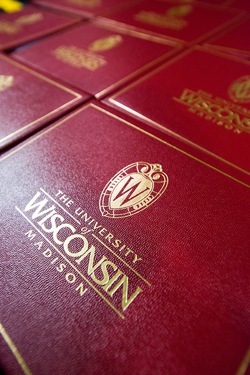Degree coordinators help students move forward
Days before winter commencement ceremonies, a student worker sits amidst teetering stacks of red diploma covers. None contain diplomas. Still, each one needs a plastic insert and an informational sheet, so the student must wade through the stacks one at a time.
Flip it open; stuff it; close it up; stack it: only a few thousand to go.
Commencement season ramps up the workload in Degree Audit and Diploma Services (DADS), part of the Division of Enrollment Management. The services they provide throughout the year help students and alumni calculate – and celebrate – years of hard work.
This year’s winter commencement will be held on Sunday, Dec. 18 at the Kohl Center.
The University of Wisconsin–Madison recently announced that it conferred more than 10,000 degrees during the 2010-11 academic year, the first time it had passed that mark. 6,579 students received bachelor’s degrees; 2,105 received master’s degrees; 754 received research doctorates and 661 received professional or clinical doctorates.
“May was the biggest class we’d ever had,” says Joan Irwin, manager of DADS. “We were getting down to the bottom of our diploma cover stacks. There were guys under the stage handing them up. It was scary. The last thing you want is to run out of covers.”
Six people, including students, work in the office. Margie Whalen, diploma services specialist, manages degrees for certain schools and colleges; she also controls diplomas. Chris Moore audits degrees for Letters and Science students and backs Whalen up; a half-time worker audits degrees for the School of Education. Student workers check the degrees and mail out diplomas.
Whalen recently marked her 35th year in the office. She’s heard it all: calls wondering why the actual diploma isn’t in the holder; questions about the amount of an unpaid library fine holding up the diploma release; students with double and triple majors wondering when their additional diplomas will arrive.
“When Biddy Martin first became chancellor, we got a call from someone’s mother,” Whalen recalls. “She didn’t want the diploma signature to say ‘Biddy’ – she wanted it to say ‘Carolyn.’”
Despite occasional exasperation, Whalen is kindly and patient as she explains one policy, then another to a walk-in student. Step by step, she describes what he needs to do to receive his diploma.
Commencement season or not, Whalen always has something to do. Information comes in every day: an incomplete class fulfilled, a credit transferred. Degrees left unfinished years ago can suddenly move through the system, ready for a diploma. Students receiving a doctorate can deposit a dissertation at any time, although the conferral date will still be listed as the date of commencement. Degree posting never stops.
Each day, Whalen receives information from schools and departments across campus. DADS staffers verify information for Letters and Science and the School of Education via departmental advisors who have verified via DARS; other schools and colleges simply send a list of students. Different departments have different timelines, but at the semester’s end this may take three to six weeks.
Whalen then sends one batch of information – names, degrees, dates – to the printers each week. Four to five weeks later, the diploma is ready to mail.
Before each semester, Whalen sends a new template (carefully checked) to diploma printers Herff Jones, updating the conferral date as well as the names of the chancellor, UW System president and Board of Regents chair.
The relationship with Herff Jones is a step up from one previous contractor. In 1988, more than 4,000 diplomas went out listing the state’s name as “Wisconson”— oddly enough, an error not reported for six months.
“I was at Green Bay at the time, and they did it there, too,” says Irwin. “It was horrible.”
“We do proofread, but we usually stick to names and degrees. We assume that the template is correct,” says Whalen. “It made it to Johnny Carson. We’ll never live that down.”
During the years, the size and style of the diploma has changed, too, expanding to its current size of 8.5 inches by 11 inches in response to repeated complaints – one woman describing the older, smaller diplomas as “postcards.”
Some recipients may seem indignant, but it reflects their deep reverence for the diploma itself.
“It’s just amazing how important this is,” says Irwin, gesturing at a sample diploma. “You try to explain: ‘Your transcript is what you’ll use to apply to grad school, or a job; nobody’s going to want to see this.’ For international students, this has a whole different meaning than it does in our country.”
The biggest and least understood issue comes from an obscure university policy. Students receiving bachelor of arts or bachelor of science degrees do not have their majors listed on the diploma. Although master’s degree recipients do, most doctoral students do not either.
Whalen makes sure the students get fair warning. Each semester, she runs “Countdown to Commencement,” a workshop what to look for, where to mail a diploma, what it will look like. She also reminds them to pay library fines, settle tuition payments and schedule an exit interview for financial aid. Diplomas can’t go out if the student has a hold on his or her record.
There’s just one more catch: a student has to actually sign up to graduate. Nothing is left to chance.
As box after box fills with the red folders, Irwin reflects on her work. It may seem bureaucratic at times, but she knows her staffers play a big part in helping students’ transition to new lives.
“It’s very emotional when they get this piece of paper,” says Irwin. “I’m sure lots of people just throw it in a drawer and forget about it, but for others, it’s monumental. And as we get more students who get deep in debt for their education, I think it means more.”

